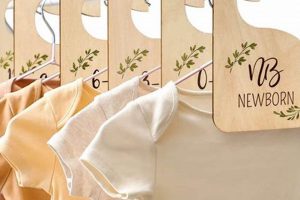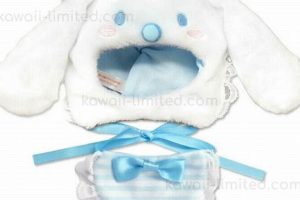The methods employed to keep infant apparel organized and protected from damage are essential aspects of household management. Proper preservation techniques ensure the longevity and cleanliness of these garments, mitigating issues such as mildew, insect infestation, and degradation of fabric. An example includes utilizing vacuum-sealed bags for long-term storage to minimize space and prevent exposure to environmental factors.
Effective garment preservation offers multiple advantages, including cost savings by extending the usable life of items and sentimental value by maintaining clothing for future generations. Historically, storage techniques have evolved from simple chests to specialized containers and systems designed to address specific environmental concerns and material compositions. These methods have become increasingly important as textile production diversifies and families seek to maximize resources.
Subsequent sections will address specific strategies for categorizing, cleaning, and packaging infant garments. Examination will also be given to optimal environmental conditions for preservation, including temperature and humidity control, and methods for preventing common forms of damage. Furthermore, consideration will be given to space-saving solutions and the sustainable reuse of storage materials.
Essential Strategies for Infant Garment Preservation
The following guidelines offer proven strategies to safeguard infant apparel against damage, ensuring its longevity and maintain cleanliness.
Tip 1: Sort by Size and Type: Implement a categorization system based on size (e.g., newborn, 0-3 months) and garment type (e.g., onesies, pants, outerwear). This facilitates easy retrieval and prevents unnecessary rummaging.
Tip 2: Launder Before Storing: Ensure all items are thoroughly cleaned prior to packing. Residual stains can attract insects or lead to discoloration over time. Utilize a gentle, fragrance-free detergent to minimize fabric irritation upon future use.
Tip 3: Utilize Acid-Free Materials: Employ acid-free tissue paper or archival boxes to protect delicate fabrics from yellowing or deterioration. Avoid cardboard, which can release harmful acids.
Tip 4: Vacuum-Seal for Long-Term Preservation: Vacuum-sealed bags offer superior protection against moisture, dust, and pests. This method is especially effective for clothing intended for long-term storage. Exercise caution with delicate items, as compression can cause creasing.
Tip 5: Control Environmental Conditions: Store clothing in a cool, dry, and dark environment. Excessive humidity can promote mold growth, while exposure to sunlight can fade colors. A temperature-controlled storage space is ideal.
Tip 6: Monitor Regularly: Periodically inspect stored garments for signs of damage, such as insect infestation or mildew. Early detection allows for prompt intervention and prevents widespread issues.
Tip 7: Label Clearly: Affix clear, durable labels to each storage container, indicating the contents and size range. This streamlines the retrieval process and prevents misidentification.
Adherence to these guidelines ensures optimal preservation of infant garments, safeguarding against potential damage and ensuring readiness for future use. The application of these strategies protects a family’s investment and preserves potentially sentimental items.
Subsequent sections will provide additional detail on the selection of appropriate storage containers and the management of specific fabric types.
1. Cleanliness
Maintaining a high standard of cleanliness is paramount when preserving infant garments. The presence of residual dirt, food particles, or bodily fluids can initiate degradation processes, compromising fabric integrity and attracting pests. Implementing rigorous cleaning protocols prior to storage is thus essential for long-term preservation.
- Preventing Microbial Growth
Unwashed garments provide a breeding ground for bacteria and fungi, leading to unpleasant odors, fabric discoloration, and structural damage. Washing removes these microorganisms, mitigating the risk of deterioration during storage. For instance, lingering milk residue on a bib can foster mold growth in a confined space.
- Repelling Pests
Traces of food or skin cells attract insects, such as moths or carpet beetles, which can cause significant damage to fabrics. Thorough cleaning eliminates these attractants, thereby minimizing the risk of infestation. An example would be the removal of formula stains from a receiving blanket to deter insects from nesting within the fibers.
- Preserving Fabric Integrity
Dirt and grime can act as abrasive agents, weakening fabric fibers over time. Removing these particles through proper washing helps maintain the material’s strength and flexibility. For example, accumulated dirt on the knees of baby pants can lead to premature wear and tear if not removed before storage.
- Minimizing Stain Setting
Untreated stains tend to oxidize and become more difficult to remove over time. Prompt washing prevents stains from setting, preserving the garment’s original appearance. Consider a spilled fruit stain on a light-colored onesie, which, if left unwashed, can become permanently embedded in the fabric.
The facets of cleanliness collectively contribute to the effective preservation of infant clothing. By mitigating microbial growth, repelling pests, preserving fabric integrity, and minimizing stain setting, proper cleaning practices ensure the longevity and usability of these garments. The application of these principles not only safeguards the physical integrity of the clothing but also maintains hygienic conditions for subsequent use.
2. Size Categorization
Effective infant garment management necessitates meticulous size categorization as a cornerstone of any storage strategy. Organizing apparel according to size ranges optimizes space utilization, facilitates efficient retrieval, and minimizes garment handling, thus contributing to overall preservation efforts.
- Space Optimization
Grouping clothing by size allows for efficient packing and storage. Utilizing containers specifically sized for particular age ranges minimizes wasted space and creates a more organized storage environment. For instance, storing newborn items separately from 6-month-old clothing allows for more compact arrangements and prevents larger garments from compressing smaller ones.
- Inventory Management
Categorization by size enables accurate tracking of available clothing. This is particularly useful for families with multiple children or those anticipating future use. Knowing the quantity and type of items available within each size range simplifies wardrobe planning and reduces unnecessary purchases. For example, a clear inventory of 3-6 month clothing prevents redundant buying of similar items.
- Damage Mitigation
Appropriate sizing during storage reduces stress on garment fibers. Overstuffing containers with mixed sizes can lead to wrinkling, stretching, or distortion of delicate fabrics. Storing items in correctly sized containers ensures they maintain their original shape and appearance. A prime example is preventing the stretching of smaller onesies when stored alongside larger, bulkier items.
- Efficient Retrieval
Categorized storage expedites the process of locating specific items. Clearly labeled containers corresponding to size ranges enable quick identification and retrieval of desired garments, minimizing the need to rummage through unsorted piles. This is especially useful when preparing for travel or transitioning between seasons. The ability to quickly locate 0-3 month sized outfits avoids frustration and saves time.
The multifaceted benefits of size categorization underscore its importance in the context of infant garment preservation. By optimizing space, facilitating inventory management, mitigating damage, and streamlining retrieval, this organizational strategy ensures that clothing remains accessible, well-maintained, and ready for use when needed. Consequently, implementing size-based categorization is a foundational element of any successful infant garment storage system.
3. Material Compatibility
The intersection of material compatibility and infant garment preservation dictates the longevity and condition of stored apparel. Incompatible materials can lead to accelerated degradation, discoloration, or physical damage. The selection of appropriate storage mediums, therefore, is a critical component of effective garment management. Ignoring material interactions can negate other preservation efforts, resulting in preventable loss. For example, storing delicate cotton items within untreated cedar chests can result in discoloration and potential damage from the cedar oils.
Practical application necessitates careful consideration of fabric composition and storage medium properties. Natural fibers like cotton and linen benefit from breathable storage containers, preventing moisture buildup and mildew formation. Synthetic materials, while generally more resilient, may react negatively with certain plastics, causing staining or structural weakening. Acid-free storage solutions are essential for preserving sensitive materials like silk or wool, mitigating acid migration from storage boxes to fabrics. Selecting polyethylene bags, as opposed to PVC, reduces the risk of plasticizer transfer, which can stiffen or discolor garments over extended storage periods.
The principle of material compatibility serves as a cornerstone of successful infant garment preservation. Overlooking potential interactions between fabrics and storage containers increases the risk of irreversible damage, undermining long-term storage goals. By prioritizing material compatibility, individuals can effectively extend the lifespan of infant apparel, ensuring its availability for future use while maintaining its original quality and aesthetic appeal. The challenge lies in identifying and mitigating potential incompatibilities before storage, thereby averting preventable deterioration.
4. Environmental Controls
The surrounding environment exerts a significant influence on the longevity and condition of stored infant apparel. Precise regulation of specific environmental factors is essential for mitigating degradation processes and preserving fabric integrity. Environmental controls encompass several interrelated elements that collectively contribute to the long-term viability of stored garments. Careful attention to these factors represents a proactive approach to managing potential risks associated with prolonged storage.
- Temperature Regulation
Maintaining a stable, moderate temperature minimizes the risk of condensation and subsequent mold or mildew growth. Fluctuations in temperature can induce expansion and contraction of fabric fibers, leading to weakening and distortion over time. An ideal temperature range for garment storage is between 60-70 degrees Fahrenheit (15-21 degrees Celsius). For example, an uninsulated attic subject to extreme temperature swings would be an unsuitable storage location.
- Humidity Control
High humidity levels promote the proliferation of mold, mildew, and insects, all of which pose a direct threat to stored clothing. Conversely, excessively dry conditions can lead to desiccation and embrittlement of certain fabrics. Maintaining a relative humidity level between 45-55% is generally recommended. A basement susceptible to moisture intrusion requires dehumidification to prevent damage to stored garments. The implementation of desiccants in sealed containers provides a localized means of moisture control.
- Light Exposure Mitigation
Prolonged exposure to direct sunlight or artificial light can cause fading, discoloration, and weakening of fabric fibers. Ultraviolet (UV) radiation is particularly damaging to delicate materials. Storage areas should be shielded from direct light sources, and clothing should be stored within opaque containers or protective coverings. Garments stored near a sun-facing window will likely exhibit accelerated fading compared to those stored in a dark closet.
- Air Quality Management
Exposure to pollutants, dust, and odors can compromise the integrity and freshness of stored garments. Airborne particles can embed themselves within fabric fibers, causing discoloration and accelerating degradation. Storage areas should be well-ventilated but protected from external contaminants. Storing clothing near volatile organic compounds (VOCs), such as paint or cleaning supplies, can result in odor absorption and potential fabric damage. Air purification systems can assist in maintaining optimal air quality within storage environments.
These facets of environmental control highlight the importance of creating a stable and protective storage environment for infant apparel. Neglecting these considerations can negate other preservation efforts, resulting in preventable damage and reduced garment lifespan. By prioritizing temperature regulation, humidity control, light exposure mitigation, and air quality management, individuals can effectively safeguard their stored clothing, ensuring its availability and usability for future generations.
5. Secure Containers
The effectiveness of preserving infant apparel is directly proportional to the security afforded by chosen containers. These receptacles serve as the primary barrier against external factors detrimental to fabric integrity, including physical damage, pests, and environmental contaminants. Selection of appropriate storage containers is thus a critical determinant of successful long-term preservation. The causal link between secure containment and garment longevity is substantiated by the increased incidence of damage among improperly stored items. For instance, clothing stored in open cardboard boxes is demonstrably more susceptible to insect infestation and moisture absorption compared to items sealed within airtight containers.
Practical application of this principle necessitates careful evaluation of available storage options. Vacuum-sealed bags effectively minimize volume and prevent exposure to air and moisture, offering optimal protection for infrequently used items. However, these bags may not be suitable for delicate fabrics prone to creasing or compression damage. Durable plastic bins provide a robust barrier against physical impacts and pests, but require proper ventilation to prevent moisture buildup. Acid-free archival boxes offer a chemically inert environment for preserving heirloom garments, mitigating the risk of discoloration or degradation. A balanced approach, considering both the protective qualities of the container and the specific needs of the stored fabrics, is paramount. For example, a mother storing her infant’s christening gown may opt for an acid-free archival box, lined with acid-free tissue paper, rather than a plastic bin. This choice reflects the gown’s delicate nature and its sentimental value.
In conclusion, the connection between secure containers and successful infant garment preservation underscores the importance of proactive risk management. The selection of appropriate containers represents a crucial preventative measure against various forms of damage, ranging from physical impacts to environmental contamination. The challenge lies in aligning the protective qualities of the container with the specific needs of the stored fabrics. Prioritizing this aspect of garment management ultimately ensures the longevity and usability of stored apparel, safeguarding both financial investment and sentimental value.
Frequently Asked Questions
The following questions address common concerns and misconceptions related to preserving infant clothing, offering guidance on best practices and potential pitfalls.
Question 1: Is it necessary to wash infant garments before storing them?
Yes, laundering is critical. Residual stains, dirt, or bodily fluids attract pests, promote microbial growth, and accelerate fabric degradation. Gentle, fragrance-free detergents are recommended.
Question 2: What is the optimal method for long-term preservation of delicate fabrics?
Vacuum-sealed bags offer superior protection against moisture and pests, but compression can damage delicate materials. Acid-free archival boxes, lined with acid-free tissue paper, provide a chemically inert and structurally supportive environment.
Question 3: How should infant garments be protected from insect infestation during storage?
Thorough cleaning prior to storage eliminates attractants. Vacuum-sealed bags provide a physical barrier. Cedar blocks or lavender sachets offer natural repellents, but direct contact with fabrics should be avoided to prevent staining.
Question 4: What are the recommended environmental conditions for storing infant clothing?
A cool, dry, and dark environment is optimal. Temperature should be maintained between 60-70 degrees Fahrenheit (15-21 degrees Celsius), and relative humidity between 45-55%. Direct sunlight and excessive temperature fluctuations should be avoided.
Question 5: Are plastic storage bins suitable for preserving all types of infant garments?
Durable plastic bins provide physical protection but can trap moisture, leading to mold growth. Proper ventilation is essential. Polyethylene bags are preferred over PVC, which can leach plasticizers that damage fabrics.
Question 6: How frequently should stored infant garments be inspected for signs of damage?
Periodic inspection is recommended, ideally every 6-12 months. Early detection of insect infestation, mildew, or discoloration allows for prompt intervention and prevents widespread damage.
The principles outlined in these questions underscore the importance of proactive measures in preserving infant clothing. A combination of proper cleaning, appropriate storage materials, and controlled environmental conditions maximizes garment longevity.
Subsequent sections will address advanced techniques for preserving specific fabric types and managing heirloom garments.
Conclusion
The exploration of techniques relevant to garment preservation reveals that effectiveness necessitates a multifaceted approach. The integration of meticulous cleaning protocols, judicious selection of storage materials, diligent categorization practices, and conscientious environmental control is indispensable. Each element contributes synergistically to the overarching objective: the mitigation of degradation processes that threaten fabric integrity and the safeguarding of clothing against damage.
The systematic application of these guidelines ensures the sustained usability and aesthetic appeal of infant garments. By prioritizing preservation, individuals safeguard financial investments and uphold the sentimental value associated with these articles. The enduring benefits extend beyond mere conservation, contributing to responsible resource management and the potential for intergenerational transfer of cherished items. Therefore, the adoption of these established methodologies represents a prudent course of action.







